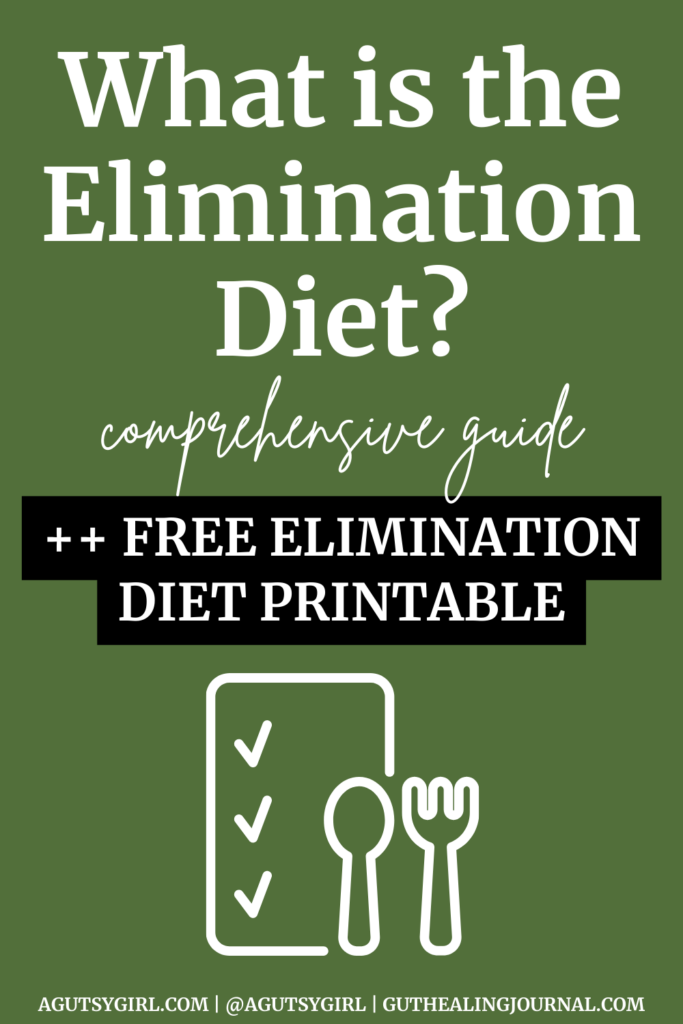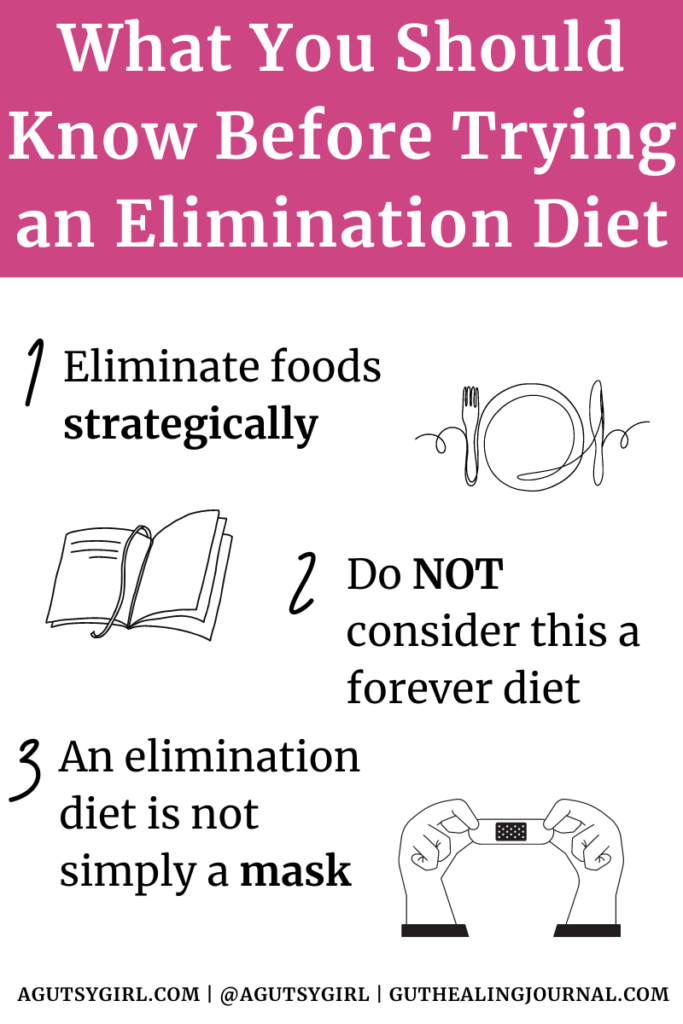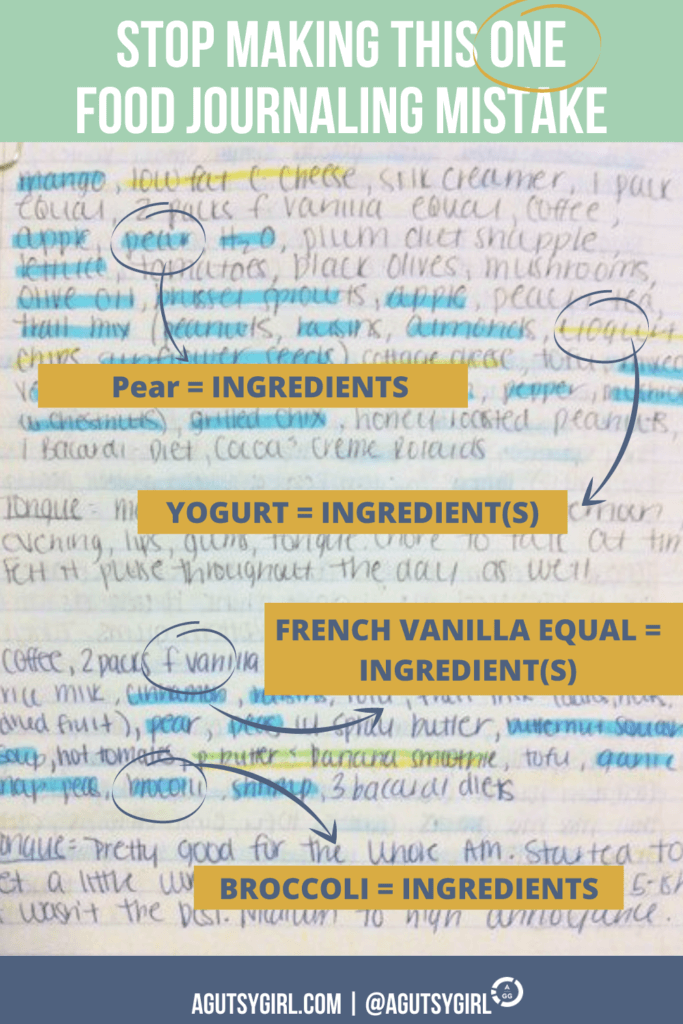Not only am I sharing my printable elimination diet , but I’m also taking you through everything you need to know about a food-elimination diet.
Yes, including a how to and recipes to help get you started.
In 2007/2008, I walked into an allergy specialist’s office. This was the beginning of all my testing. The allergist did probably 100 prick tests, testing for food allergies. Nothing. Nope. Not even mildly allergic to one thing.
So she told me that because I was having so many digestive issues and “other” issues, she highly recommended I go on an elimination diet to find out which foods I was intolerant to.
She gave me a sheet which was vague and confusing, but at least a start.
She then said,
Read the instructions (the sheet she gave me had “instructions”). Avoid one food group for a few days. Then, add that food back in, note your symptoms and move on to the next until you have done trial-and-error on all. This will tell you which foods don’t agree with your stomach, creating the intolerance.
I went home. I followed her instructions. Nothing changed. My stomach got far worse before it got better.
Why?
I’d learn years later that I was allergic to nothing; intolerant to everything because my gut was leaky, I had SIBO (small intestinal bacterial overgrowth), a low-functioning thyroid, irritable bowel syndrom, Colitis, and “adrenal fatigue.”
You name it; I seemingly had it.
However, besides the detailed testing that would happen later down the line, my first taste of healing happened when I put myself on a real elimination diet. No, not the allergists’ elimination diet.
Instead, one that I had crafted and created with the help of schooling, a nutritionist, and my own research.
But in hindsight, I didn’t do many things right.
I’ll fully admit it so that you don’t have to make the same mistakes I did.
What is The Elimination Diet
Click HERE to save this post for later.

The ultimate goal of the elimination diet is to figure out which foods your body is reacting to and/or not responding well to.
Reactions could be generalized stomach pain, skin problems like eczema, general rashes and acne, bloating, diarrhea, etc. There are a variety of symptoms you may currently be experiencing – none of which are pleasant. Believe me, I know.
Really, anytime your body is presenting signals that something is not right, the chances that it’s food related are fairly high.
An elimination diet involves removing those foods during an elimination period, and then later reintroducing them, one at a time.
Simultaneously, you’ll watch for symptoms that show a reaction.
The process takes a slow-and-go approach.
Food Allergy vs Food Sensitivities
Before we continue on, I want to quickly touch on the fact that a food allergy is different from a food sensitivity.
Food Allergies
A food allergy is an “immune system reaction that occurs soon after eating a certain food. Even a tiny amount of the allergy-causing food can trigger signs and symptoms such as digestive problems, hives or swollen airways.”
It may or may not cause an anaphylactic reaction.
The most common food allergy signs and symptoms include:
- Tingling or itching in the mouth
- Hives, itching or eczema
- Swelling of the lips, face, tongue and throat or other parts of the body
- Wheezing, nasal congestion or trouble breathing
- Abdominal pain, diarrhea, nausea or vomiting
- Dizziness, lightheadedness or fainting
IGG food allergies often include immediate responses and symptoms to a food and are much more dangerous than food sensitivities.
It is important to get checked for food allergies if you are experiencing any of these symptoms.
Some of the top IgE food allergies include:
- dairy
- eggs
- fish
- shellfish
- soy
- wheat
- soybeans

Food Intolerance and Hypersensitivity
Yes, these two are basically the same thing.
“Food intolerance, also known as non-IgE mediated food hypersensitivity or non-allergic food hypersensitivity, refers to difficulty in digesting certain foods.”
A food intolerance and hypersensitivity will not trigger an allergic reaction.
However, it can cause a whole host of unpleasant symptoms such as abdominal pain, gas, bloating, headaches, and heartburn.
A food intolerance occurs when the digestive system fails to break down certain foods. It often can be due to a lack of pancreatic enzymes or certain developments over time, such as a lactose intolerance.
It also is often linked with increased iGg proteins, which can trigger an overactive immune response. This can cause inflammation and discomfort, especially in the gut region.
Food intolerances are extremely commonly, and it is where the majority of the Gutsy community falls. And while it’s not life-threatening, it’s frustrating because a food intolerance has a delayed response. It can take anywhere from hours to days to show up after eating specific foods.
Thus, people tend to spin their wheels for years trying to figure out what’s wrong.
Some even go their entire lives without pinpointing which specific foods are giving them issues.
What You Should Know Before Trying an Elimination Diet

I promise that when I share these next three items, I know what I’m talking about.
So please, believe me on them.
1. Eliminate foods strategically
What I mean is, “Don’t think you need to eat three total foods for an extended period of time in order for this to work.”
Seriously. That’s not a strategy; that’s just not eating.
For example, I would not recommend the six-food elimination diet, but if that’s what your individual needs are then by all means – go for it.
This, combined with number 1 under “How to Do an Elimination Diet” below are the reasons why this is so hard and confusing.
I can’t actually tell you how to eliminate foods strategically or how to plan the foods and rotation you’ll take. Because it’s a super customized approach, in my opinion.
I can, however, get you started with my printable elimination diet (more on this below).
2. Do not consider this a forever diet
So your phase one of the diet is working super well, in the sense that your symptoms are gone.
That’s great! But that does not mean those 23 foods are your staple, forever foods.
Do not plan to stay on any one phase for longer than a week or two. Most experts agree that the total length for an elimination diet is 5-6 weeks.
This is a short-term eating plan. End of story.
3. It’s not a mask
You know deep down if you have an unhealthy relationship with food. If that’s you, do not go down this rabbit hole.
Do not use your health issues as an excuse to eat even less on an elimination diet. I say this with the most compassion possible.
All of your issues will only worsen by eating even less and obtaining a smaller variety of foods. If you have a ton of symptoms and GI issues, find an alternative to the elimination diet.
How to Do an Elimination Diet

The first thing you should know about the elimination diet is that it is not easy.
And the second thing you should know is that there are a plethora of ways to do it instead of a classic way to do it.
Take for instance what Healthline says.
Do Not Eat
- Citrus fruits: Avoid citrus fruits, such as oranges and grapefruits
- Nightshade vegetables: Avoid nightshades, including tomatoes, peppers, eggplant, white potatoes, cayenne pepper and paprika
- Nuts and seeds: Eliminate all nuts and seeds
- Legumes: Eliminate all legumes, such as beans, lentils, peas and soy-based products
- Starchy foods: Avoid wheat, barley, corn, spelt, rye, oats and bread. Also avoid any other gluten-containing foods.
- Meat and fish: Avoid processed meats, cold cuts, beef, chicken, pork, eggs and shellfish
- Dairy products: Eliminate all dairy, including milk, cheese, yogurt and ice cream
- Fats: Avoid butter, margarine, hydrogenated oils, mayonnaise and spreads
- Beverages: Avoid alcohol, coffee, black tea, soda and other sources of caffeine
- Spices and condiments: Avoid sauces, relish and mustard
- Sugar and sweets: Avoid sugar (white and brown), honey, maple syrup, corn syrup and high-fructose corn syrup, agave nectar, desserts and chocolate
Note: If you suspect that other foods not on this list make you feel uncomfortable, it is highly recommended to remove them as well.
Can Eat
Some foods you can eat include:
- Fruits: Most fruits, excluding citrus fruits
- Vegetables: Most vegetables, excluding nightshades
- Grains: Including rice and buckwheat
- Meat and fish: Including turkey, lamb, wild game and cold-water fish like salmon
- Dairy substitutes: Including coconut milk and unsweetened rice milk
- Fats: Including cold-pressed olive oil, flaxseed oil and coconut oil
- Beverages: Water and herbal teas
- Spices, condiments and others: Including black pepper, fresh herbs and spices (excluding cayenne pepper and paprika) and apple cider vinegar
This is what makes the elimination diet so hard.
Taking the above into consideration, here is how to go about the food elimination diet process
Here is my process for how you can find possible food triggers.
1. Plan your foods
Make a jumbo list of everything you know you can eat. Use the lists above as guidelines, if desired.
Otherwise, the very best thing to do would be to work with someone 1-on-1 to craft the best possible elimination diet for you, as there are so many ways to go about it. Choose a registered dietitian, qualified holistic health coach, or other medical practitioner who has experience with this.
2. Simplify your meals
From those foods, plan meals. Simplify them and make them as minimal as possible.
If you don’t, it will be too hard to know which food you reacted to.
Think 3-4 ingredients: rice, green beans, salmon, and olive oil.
But remember, there is a difference between ingredient s and ingredients.
This is one of my very first elimination diet tracking records.
It’s not the way to do it.

3. Track daily
In order for this to work, you’ll need to track food and food intolerance symptoms daily.
There are so many ways to go about this.
It comes down to understanding the best method for you. However, I can take this tracking daily guesswork out of the equation for you with my ultimate gut healing journey journal method HERE.
Seriously, do not skip this step.
It is an easy way to clearly see exactly what’s going on.
4. Make a reintroduction plan
HERE is how I recommend doing this.
This step is critical.
Remember, the Elimination Diet is intended to be short. This is not a lifelong plan; please don’t understand it to be that.
You absolutely must reintroduce foods. In fact, that’s the only way to determine what you’re reacting to — if you do it correctly.
The foods during the first few days shouldn’t cause reactions. It’s the ones you add later that will.
The best way I know how to do this is by strategically adding in one item (or food group/category), and then waiting 1-3 days to watch for reactions (that’s how long reactions can take to show up; up to 72 hours).
During this time, meticulously track and record. If no reactions, continue adding food back in.
Finally, once the process is complete, you’ll need to work with a doctor to understand why you might be reacting to any of the foods you reacted to.
Because no, no it’s not normal. Common? Yes. Normal? No.
Printable Elimination Diet
Click HERE to save the printable elimination diet for later.

Alright, and now for the part you’ve been waiting for and wanting to grab – a printable elimination diet.
I have put together 101 foods in PDF format that you can use for Phase 1 of your elimination diet.
>>>>Get the printable PDF HERE.<<<<
A couple notes on the PDF:
- This is NOT SIBO-specific. If you are looking for a printable to help with a low-FODMAP diet, you’ll find that HERE.
- Remember that even though these are “healthy foods,” they might not be healthy for you right now. Work with your health condition, not against it.
- While this is a food list to help with Phase 1 of an elimination diet, remember that quantities of food matter and you’ll need to keep track of all that. Again, a plug for the journal above because it’s probably the best tool you can have for your journey. For example, 1/2 – 1 cup blueberries might work for you, but then 2 cups may no longer be okay.
Elimination Diet Recipes
Now, I wanted to provide some recipes to prove that this can be done. However, you must know that these are subjective because everyone can and should go about elimination and re-introducing in a way customized for them.
- Chicken Bone Broth
- Lemon and Dill Broiled Salmon (p. 106 in The Leaky Gut Meal Plan)
- Sunrise Nori Wraps
- Guilt-Free Turkey Burgers (p. 98 in The Leaky Gut Meal Plan)
- Instant Pot Vegetable Broth
- The bowl “recipe” at the top of THIS post
- Coconut Yogurt
- Maple-Balsamic Vinegar-Roasted Carrots (p. 137 in The Leaky Gut Meal Plan)
- Autoimmune Paleo Bread (p. 56 in The Leaky Gut Meal Plan: 4 Weeks to Detox and Improve Digestive Health or HERE)
- Strawberry-Vanilla Smoothie (p. 73 in The Leaky Gut Meal Plan)
- Keto Coconut Butter Bites
- Blueberry Smoothie Bowl (p. 74 in The Leaky Gut Meal Plan)
- Baked Garlic Chicken Drummies (p. 92 in The Leaky Gut Meal Plan)
And so many more from The Leaky Gut Meal Plan: 4 Weeks to Detox and Improve Digestive Health.
If you have my book, A Gutsy Girl’s Bible: a 21-day approach to healing the gut, there are 100+ food creations for you to use and enjoy, as they fit into your plan. (Hint: In the book, I also teach you why this recipe method is superior when healing your gut.)
Looking for some easy elimination diet on-the-go options? Everything (number 4 could be debatable) from my 11 Favorite AIP Packaged Foods List.
Will I Miss Out on Nutrients if I Do an Elimination Diet?
I’m often asked,
But won’t I be missing out on too many vital nutrients while on an Elimination Diet?
And here’s my answer: probably not, but maybe; it likely doesn’t matter.
Blunt, but true.
Here’s why:
- Remember, this is intended for a very short duration. You cannot become severely deficient in anything in a short window. And honestly? You are not deficient in gluten-free foods 🙂
- If there is something you’re reacting to, you’re either not absorbing the nutrition properly anyways so getting it out might help your body repair to absorb other vital nutrients.
The idea that you’ll become so undernourished if you do an elimination diet is ludicrous to me.
And by the way, if you’re really concerned just skip this method altogether and get tested to drill down more.
If you’ve never had any gut health or general health testing done up until this point, that might be the better route to take as a starting point.
Here are two resources to help get you started:
If you’re looking for more help and getting started today on a gut healing and health journey, check out:
Xox,
SKH
🤰 bloating be gone! weight loss through optimal gut health for women
💃ʜᴇᴀʟ ʏᴏᴜʀ ɢᴜᴛ. ʜᴇᴀʟ ʏᴏᴜʀ ʟɪfe.
🫶🏻 founder gutbyome.com






![Chunky Monkey [the best nice cream you’ve ever had]](https://agutsygirl.com/wp-content/uploads/2018/04/chunky-monkey-chocolate-ice-cream-featured.png)

i think it so so good to do this yearly, yes? I need to do it again! thanks!!
You can do it as often as you need. It’s not so much a “detox” or “cleanse” as it is simply a method to figure out your offending foods so you can move up and on with your life:)
Is it possible to eliminate all the bad and then introduce things gradually back in to see how it effects you?
It is possible. The only problem with that is that the word “bad” is very subjective. That being said, the elimination diet is essentially eliminating “all the bad” and gradually reintroducing to find out what is truly bad and what is not bad for YOUR body.
I am highly interested in learning more about this. I was just told my case on the wait list at the Mayo Clinic is no longer on the waitlist as the list has gotten longer and they are only taken certain patients. I guess 14 procedures/tests and seeing 7 doctors with no answers isn’t on their top priority list. I am gonna have to do this myself apparently.
I am SO sorry, Nicole! We will get you healed.